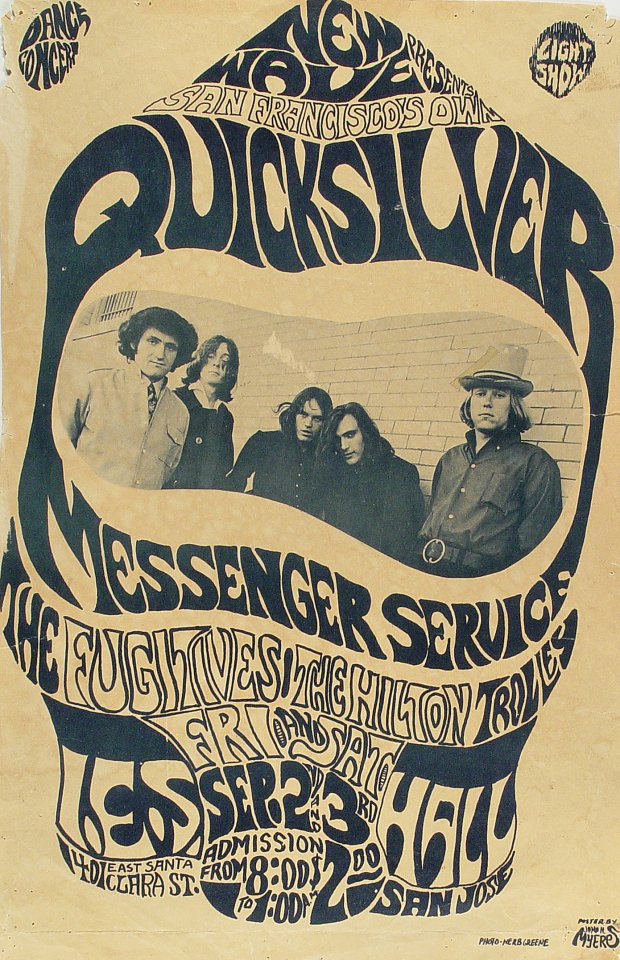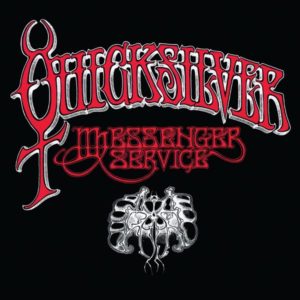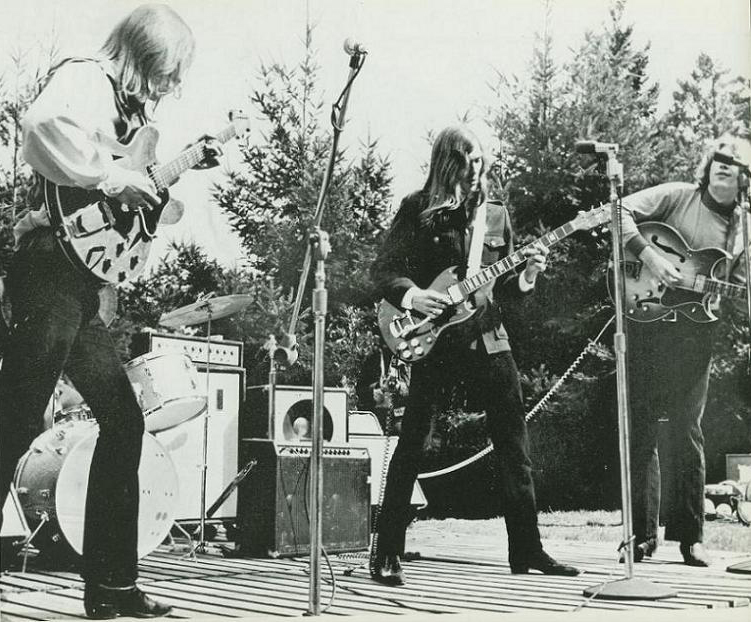Quicksilver Messenger Service 50 Years On
by John Diliberto 5/24/2018
 Take a Flashback 50 to the eponymous debut of Quicksilver Messenger Service
Take a Flashback 50 to the eponymous debut of Quicksilver Messenger Service
Quicksilver Messenger Service was formed in 1965 in the nascent days of the San Francisco psychedelic scene. This was when The Grateful Dead were still The Warlocks and The Jefferson Airplane didn’t yet have Grace Slick who was in The Great Society. But Big Brother and the Holding Company still had Janis Joplin, for the moment. There’s a little confusion about the origins, but singer Dino Valente is reputed to have initiated the band. The only problem was, the day after he did, he got busted for drug possession. After a few twists and turns, the band coalesced around guitarist John Cippolina, singer and guitarist Gary Duncan, bassist and violist David Freiberg, and drummer Greg Elmore. By 1967 they were in the forefront of the San Francisco scene, regulars at the Fillmore and playing major events like the Monterey Pop Festival. But they were one of the last of the first wave psychedelic bands to sign a record contract.
Their self-titled debut album was a mix of expansive, intricately woven journeys with twin lead guitar and older style rock tunes that in retrospect, seemed like they came from the early 60s, not the psychedelic 60s. The album is only 32 minutes long, short by even 1968 standards. But 23 of those minutes are taken up by the three songs that make the album a classic: “Pride of Man,” an instrumental called “Gold and Silver,” and the epic, 12-minute-long suite, “The Fool.”
The opening track, “Pride of Man” was written by folk singer Hamilton Camp in 1964 and was covered by Gordon Lightfoot in 1966. But it’s the QMS version that fully explores the apocalyptic and religious imagery of the song. After sliding guitar chords introduce the song, Elmore and Freiberg set up a propulsive rhythm as Gary Duncan unleashes his full-throated warning about the “flash of fire, ten times brighter than the day.” It was a great intro for this band that was somewhat muted by the next two pop flavored songs, “Light Your Windows” and “Dino’s Song” which sound more like American Bandstand fodder from 1963 or so.
 But then comes “Gold and Silver.” It was originally titled “Acapulco Gold & Silver,” named for strains of marijuana, but Capitol Records had a problem with that title. The song has kind of a jazz feel and a time signature similar to Dave Brubeck’s “Take Five.” And just check out the intertwined twin lead guitars of John Cippolina and Gary Duncan which ring out with righteous clarity.
But then comes “Gold and Silver.” It was originally titled “Acapulco Gold & Silver,” named for strains of marijuana, but Capitol Records had a problem with that title. The song has kind of a jazz feel and a time signature similar to Dave Brubeck’s “Take Five.” And just check out the intertwined twin lead guitars of John Cippolina and Gary Duncan which ring out with righteous clarity.
Another throw away tune, “It’s Been Too Long” follows before we hit the 12-minute epic that leaves me breathless every time I hear it, “The Fool.” It’s a multi-sectioned piece that flows from one mood to another. The pastoral opening section of ringing electric and acoustic guitars yields to the main melody statement played on a guitar that sounds like it was run through a ring modulator, giving it a keyboard like effect. Another jazzy section has guitars that oscillate from counterpoint to unison to accompaniment line and build up to a symphonic crescendo. Then before you know it, it’s a middle eastern groove and a growling, fuzzed and tremeloed wah-wah solo that rises into a celestial choir before dropping into the actual song part of the tune, a plaintive theme of oneness sung by Duncan. After an acoustic and spoken word breakdown, thundering guitar chords of doom come in as Freiberg unleashes a plangent viola lead that ascends to the final roaring crescendo. It was an adventurous journey even for the time.
 Quicksilver Messenger Service went on to record another great album, the live Happy Trails. Then the band started to evolve. Gary Duncan left, replaced by pianist Nicky Hopkins for another really good album, Shady Grove. Then founding member Dino Valente returned and the group’s sound really changed. They also had their only hits, “Fresh Air” and “What About Me.” David Freiberg went on to become a member of Jefferson Starship and was working with Gary Duncan as Quicksilver Messenger Service in this millennium. Greg Elmore has been silent as far as I know. John Cippolina went on to form the group Copperhead, a more straight-ahead rock affair and played with various Bay Area musicians until he left the planet in 1989 from a genetic disorder exasperated by cigarette smoking. In live photos, Cippolina always had a cigarette stuck on the headstock of his guitar. He was only 45.
Quicksilver Messenger Service went on to record another great album, the live Happy Trails. Then the band started to evolve. Gary Duncan left, replaced by pianist Nicky Hopkins for another really good album, Shady Grove. Then founding member Dino Valente returned and the group’s sound really changed. They also had their only hits, “Fresh Air” and “What About Me.” David Freiberg went on to become a member of Jefferson Starship and was working with Gary Duncan as Quicksilver Messenger Service in this millennium. Greg Elmore has been silent as far as I know. John Cippolina went on to form the group Copperhead, a more straight-ahead rock affair and played with various Bay Area musicians until he left the planet in 1989 from a genetic disorder exasperated by cigarette smoking. In live photos, Cippolina always had a cigarette stuck on the headstock of his guitar. He was only 45.
Quicksilver Messenger Service is a bit forgotten, but I hear them as one of the defining bands of San Francisco rock. Their debut and Happy Trails are on my all-time list of great albums.
Since this was written, co-founder, guitarist and singer Gary Duncan has left the planet,

John, Beautiful description of the early days and music of Quicksilver. I am glad someone still remembers and appreciates them. Although HAPPY TRAILS is a very good album, their debut is one of my absolute favorites (not a bad tune on it). I saw them at The Roxy club in Hollywood in 1975 and Cippolina (who usually wore a brown three-piece suit and tie) was phenomenal. Peace and love!
Thanks Randall! I always thought the more rock/pop tunes on the album were pretty slight, even in 1968. But Pride of Man, Gold and Silver and especially The Fool are so monumentally good, and more than two-thirds of the album, that it makes it a great album for me.
I liked them. Well written. When I lived in the SF bay area in 1970 The Sons were my fav but Quicksilver…I always had a warm spot. There was something about the passion in their guitar playing.
I love(d) QMS, especially their first eponymous LP & especially “Gold and Silver” from the album, which I think was their best instrumental. Happy Trails had lots of great live guitar jamming, but “Gold and Silver” is perfection. However, despite its obvious melodic similarity to “Take Five” by Dave Brubeck, “Gold and Silver” is NOT in 5/4 time (as “Take Five” is), but in 6/8 time – all the way through. I’ve seen so many posts stating that this song is in 5/4. It’s not. Listen to it and count it out. I just did.
Excellent article about an often overlooked but extremely talented group of artists. As a guitarist I was always in complete awe of John.
Thanks! One of my fave bands in their original recording line-up